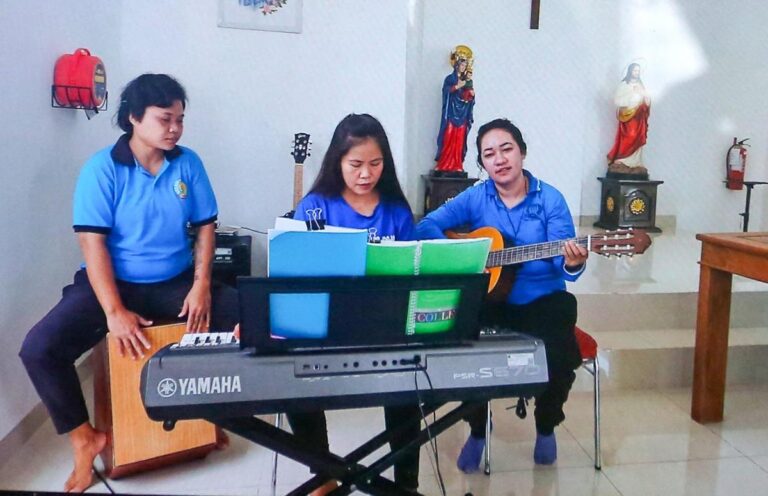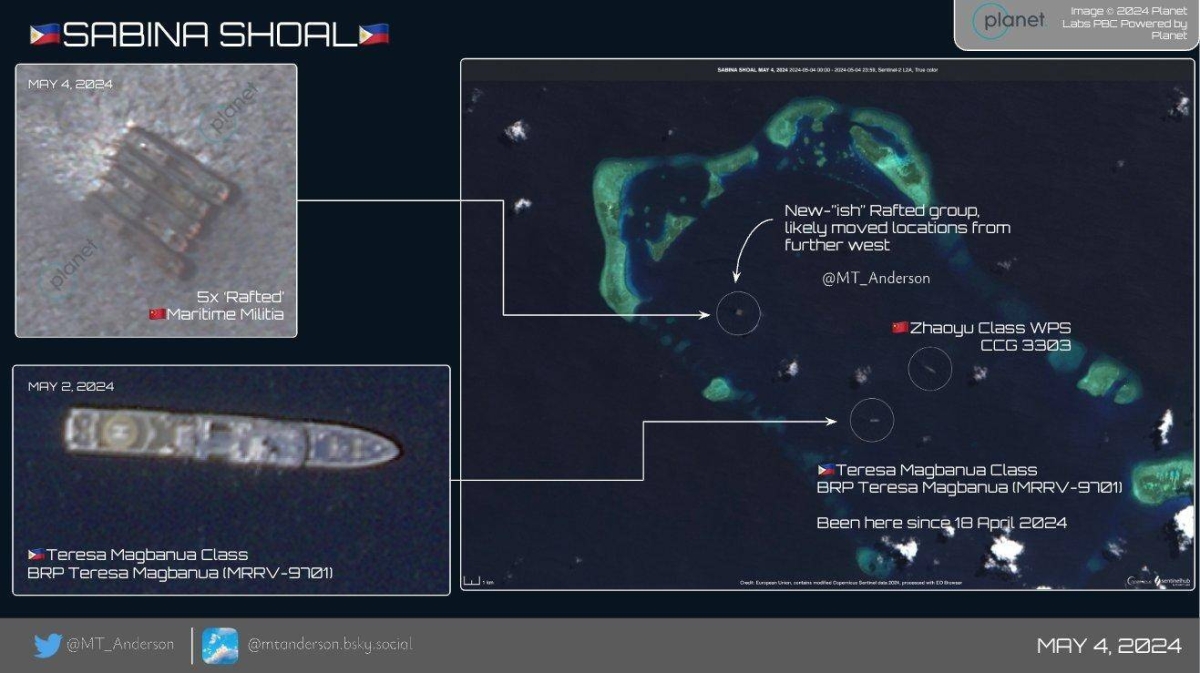ATTEMPTS by China from continuing its “reclamation activities” in Sabina (Escoda) Shoal in the West Philippine Sea (WPS) has been temporarily deterred by the Philippine Coast Guard (PCG), which deployed one of its ships to monitor the illegal activity, a spokesman for the PCG said on Saturday.
Tarriela said the presence of the BRP Teresa Magbanua in the shoal sent a strong message to the China Coast Guard (CCG) that the Philippines was not “helpless.”
“The mere fact that the Philippine Coast Guard has prevented [the] Chinese government [from] continuing their island reclamation in Sabina Shoal means we remain effective. The state has the sovereign rights over these waters,” Tarriela said.
Tarriela said the PCG had monitored 34 Chinese Maritime Militia Vessels at the Sabina Shoal with the People’s Liberation Army (PLA) Navy vessels, helicopters and four other China Coast Guard vessels.
delivered to your inbox
Two of the CCG vessels 4402 and VP03, Tarriela said, were the same ships that China has been deploying in Ayungin Shoal.
“The mere fact that the Chinese coast guard, the PLA Navy vessels, the PLA Navy helicopter [are] also restricting the Philippine Coast Guard from monitoring their activities means they must be hiding something,” Tarriela said.
The PCG spokesman said the PCG vessel had monitored the dumping of crushed corals near the Sabina Shoal, and it might be in preparation for China’s reclamation activities to build structures on top of the maritime feature.
“Here they are, just getting started. So if we say that the dumping of corals in Sandy Cay has allowed [China] to expand the land area, surface area as an artificial island, then most likely, if we don’t monitor and guard against this, perhaps in the coming months, we could be surprised that there would be large man-made islands in Sabina Shoal,” Tariela said.
Tarriela said the PCG implemented a standard operating procedure of launching Rigid Hull Inflatable Boats (RHIBs) to inspect the low-tide elevation at Sabina Shoal, particularly for any dumped crushed corals, following the results of Dr. Jonathan Anticamaran’s maritime scientific research on the sandy cays last March.
“The physical characteristics of the low-tide elevation surrounding Sabina Shoal in the West Philippine Sea are similar to those of the Sandy cays,” Tarriela said.
“It has been observed that crushed corals were dumped, and it is highly likely that the maritime features were altered,” he said.
‘Decisive action’
The PCG discovered the state of the shoal’s low-tide elevation during the extended deployment of the BRP Teresa Magbanua, the largest vessel in the PCG fleet, in Sabina Shoal, now on its 26th day of monitoring, Tarriela said.
He said the “decisive action” to deploy and extend the presence of the PCG vessel was made by the PCG Commandant Adm. Ronnie Gil Gavan in response to the presence of the Chinese Maritime Militia in the area.
The Sabina Shoal is just 75 nautical miles from the main island of Palawan, while the Ayungin Shoal (Second Thomas Shoal) is 106.3 nautical miles from the province.
China has repeatedly impeded Philippine resupply missions to Ayungin Shoal, using aggressive maneuvers, military-grade lasers, and water cannons during past incidents.
Both the Sabina and Ayungin Shoals are well within the 200-nautical mile Philippine exclusive economic zone, parts of which overlap with Beijing’s expansive claims over the South China Sea.
“So if we say that the dumping of corals in Sandy Cay has allowed China to expand the land area, surface area as an artificial island, then most likely, if we don’t monitor and guard against this, perhaps in the coming months, we could be surprised that there would be large man-made islands in Sabina Shoal,” Tarriela said.
“China’s deployment of Chinese Maritime Militia, Chinese coast guard, PLA Navy and Chinese research vessels close to the coastline of Palawan is concerning. Not only does this pose a threat to our sovereignty, but it also causes significant damage to our marine environment,” said Tarriela.
In its maritime scientific research that commenced on March 22, a team from the University of the Philippines Institute of Biology led by Dr. Anticamara learned that the Pag-asa Cays in the West Philippine Sea was in a degraded state with low coral and fish diversity and abundance.
Anticamara said the degradation of the reef biodiversity in Pag-asa Island Cays 1, 2, 3 and 4 was possibly due to a combination of disturbances from overfishing, climate change impact and island-building activities in several features in the WPS.
China warning
Meanwhile, Lin Jian, a spokesman for China’s Ministry of Foreign Affairs, warned the Philippine government against expelling its diplomats in Manila over the controversy involving a leaked conversation between Chinese Embassy officials and a military official.
“The Philippines’ response shows precisely their guilty conscience in the face of facts and evidence and how exasperated and desperate they have become. We ask the Philippines to ensure that Chinese diplomats can carry out their duty normally and to stop provocations and infringements,” said the Chinese foreign ministry spokesman during his regular press conference Friday.
Lin reacted to calls by Defense Secretary Gilberto Teodoro Jr. and National Security Adviser Eduardo Año to the Department of Foreign Affairs (DFA) to expel the Chinese diplomat who illegally recorded a phone call with the chief of the Armed Forces of the Philippines (AFP) Western Command. This action, if proven, could have severe diplomatic and legal implications.
Lin said the Philippines must refrain from making reckless moves, such as expelling Chinese diplomats, that will only backfire on the Philippines.
The Chinese Embassy in Manila on May 7 shared a phone recording between an individual claiming to be the “AFP WesCom chief” and a Chinese diplomat with selected media organizations. They reportedly agreed on four points under a “new model” for managing disputes in the West Philippine Sea (WPS). However, the authenticity of the recording has not been confirmed.
Teodoro strongly urged the DFA to initiate a thorough investigation into the alleged recording, while Año said that the Chinese officials may have violated Philippine laws, particularly the Anti-Wire Tapping Act, and profoundly breached diplomatic protocols and conventions.
Año expressed concern over the Chinese Embassy’s recurrent involvement in spreading disinformation, misinformation, and falsehoods. He pointed out their recent release of dubious transcripts or recordings of alleged discussions between officials of the host country, stating that such actions should not go unpunished or without severe consequences.
He emphasized that the clear intent of the Chinese Embassy in disseminating these fabrications and defamatory statements was to create strife, separation, and disunity among the Filipino people.
The DFA cautioned people against spreading false narratives that could create confusion and discord among agencies and the public. This includes the release of unverifiable recordings of conversations with Philippine officials.
The DFA reminded diplomats to strictly adhere to the 1961 Vienna Convention on Diplomatic Relations (VCDR), specifically Article 41, which states that all persons must respect the laws and regulations of the receiving State. They also have a duty not to interfere in the State’s internal affairs.


















